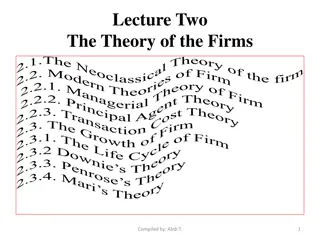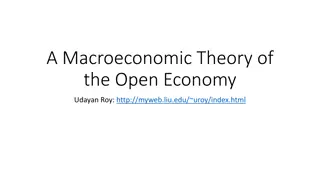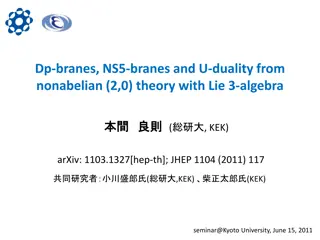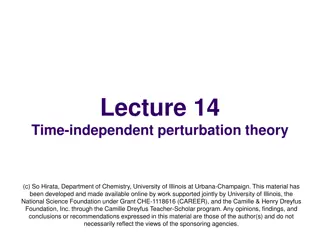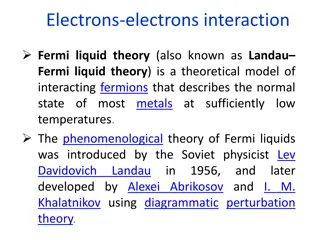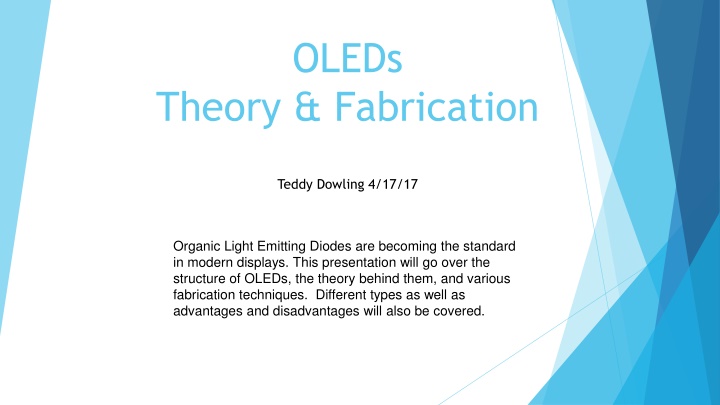
OLEDs: Theory, Structure, and Fabrication Techniques
Dive into the world of Organic Light Emitting Diodes (OLEDs) with this presentation covering the structure, theory, and fabrication processes. Learn about organic semiconductors, OLED structure, electro-phosphorescence, and the advantages and disadvantages of OLED technology.
Download Presentation

Please find below an Image/Link to download the presentation.
The content on the website is provided AS IS for your information and personal use only. It may not be sold, licensed, or shared on other websites without obtaining consent from the author. If you encounter any issues during the download, it is possible that the publisher has removed the file from their server.
You are allowed to download the files provided on this website for personal or commercial use, subject to the condition that they are used lawfully. All files are the property of their respective owners.
The content on the website is provided AS IS for your information and personal use only. It may not be sold, licensed, or shared on other websites without obtaining consent from the author.
E N D
Presentation Transcript
OLEDs Theory & Fabrication Teddy Dowling 4/17/17 Organic Light Emitting Diodes are becoming the standard in modern displays. This presentation will go over the structure of OLEDs, the theory behind them, and various fabrication techniques. Different types as well as advantages and disadvantages will also be covered.
OUTLINE Organic Semiconductors OLED Structure What they are made of Electro-Phosphorescence How they work Fabrication How they are made Types of OLEDs Advantages/Disadvantages
Organic Semiconductors Made from carbon based polymers Emit Light when electricity is applied through them Development of the technology began in the early 2000 s Most organic materials are intrinsically p- type Higher hole mobility than electron mobility Opposite of non-organic semiconductors www.physik.hu-berlin.de/sfb951/projects/topicareab/b3/pics/LUMO_HOMO.jpg
OLED Structure OLEDs are solid state semiconductors 100-500nm thick OLEDs produce holes and electrons using organic molecules Instead of using layers of n-type and p- type semiconductors OLEDs have at least six layers Modern OLEDs use many more layers for efficiency, with basic functionality remaining the same http://www.newhavendisplay.com/includes/modules/pages/oled_page/colorOLED-diagram.png
OLED Structure Substrate (clear material) Anode Removes electrons Conducting layer (P-type material) Organic plastic molecules that transport "holes" from the anode Emissive layer (N-type material) Organic plastic molecules (different than the conducting layer) transport electrons from the cathode This layer emits photons http://s.hswstatic.com/gif/oled-cell.gif Cathode Injects electrons
Electro-phosphorescence Electron-hole recombination Voltage is applied across OLED Current flows from cathode to anode through at least two organic layers Electrons flow from the cathode to the emissive layer Anode generates holes in the conductive layer by removing electrons Electron-Hole pairs are formed at the boundary between the emissive and the conductive layers The electron emits energy in the form of a photon https://www.allaboutcircuits.com/uploads/thumbnails/OLED_EarlyProduct.JPG
Electro-phosphorescence Recombination of charges leads to the emission of a photon Different materials and dopants can be used to generate different colors Frequency is given by the energy gap (E = h ) Combinations can be used to create a white light source Variable currents can increase or decrease light intensity http://lcp.elis.ugent.be/sites/lcp.elis.ugent.be/files/oledmolecules.jpg
Fabrication Three Types: 1. Vacuum Deposition/Vacuum Thermal Evaporation(VTE) 2. Organic Vapor Phase Deposition 3. Inkjet Printing
Vacuum Thermal Evaporation Done in a vacuum chamber with very low pressure Organic molecules are heated until they evaporate A cooled substrate condenses them into films Disadvantages Difficult to prevent contamination Difficult to ensure uniformity and doping concentration over large substrates Expensive http://www.clker.com/cliparts/A/Y/P/a/D/Y/vacuum-thermal-evaporation.svg
Organic Vapor Phase Deposition Also done under low-pressure in a reactor chamber with heated walls Materials are condensed into thin films on a cooled substrate. Carrier gas transports evaporated organic molecules Improves control over doping using temperature and carrier gas flow rate Advantages https://upload.wikimedia.org/wikipedia/commons/3/31/Fig.6_%28b%29_Organic_vapor_phase_deposition.JPG Increased efficiency for large-area substrates Reduced cost
Inkjet Printing Organic materials are diluted into a liquid and sprayed onto substrate Similar to other modern ink printers Prints Using vaporized organic materials instead of liquid Advantages Cheaper to manufacture using this method http://ar2015.merckgroup.com/sites/default/files/images/en/13%402x.png Allows OLEDs to be printed onto very large films (TV s, Billboards, etc.)
Types of OLEDs Transparent OLED Passive-matrix OLED (PMOLED) Active-matrix OLED (AMOLED) Foldable OLED White OLED
Transparent OLED Transparent components (substrate, cathode and anode) Up to 85 percent as transparent as their substrate when turned off Allow light to pass in both directions when turned on A transparent OLED display can be either active or passive matrix http://s.hswstatic.com/gif/oled-transparent.gif
Passive-matrix OLED (PMOLED) Strips of cathode, organic layers, and strips of anode Anode strips are arranged perpendicular to cathode strips Intersections of cathode and anode make up the pixels where light is emitted External circuitry applies current to selected strips of cathode and anode Easy to make but consume more power than other types (still less than LCDs) http://s.hswstatic.com/gif/oled-passive.gif
Active-matrix OLED (AMOLED) Full layers of cathode, organic molecules, and anode Anode layer overlays a thin film transistor (TFT) array that forms a matrix Consume less power than PMOLEDs and are very efficient for large displays Faster refresh rates http://s.hswstatic.com/gif/oled-active.gif
Foldable OLED Substrates made of very flexible metallic foils or plastics Very lightweight and durable Potentially could be attached to fabrics to create "smart" clothing https://www.oled-info.com/files/LG-Display-5-inch-flexible-OLED-prototype-sid-2013-img_assist-289x195.jpg
White OLED Emit white light that is very bright More energy efficient than fluorescent lights Reduces energy costs for lighting https://www.digikey.it/en/articles/techzone/2013/jul/~/media/Images/Article%20Library/TechZone%20Articles/2013/July/OL EDs%20Move%20Closer%20to%20Mainstream%20Lighting/article-2013july-oleds-move-closer-to-fig2.jpg
Advantages/Disadvantages Advantages Flexible, foldable, and transparent Brighter than other displays Fast Relatively easy to produce Low power consumption Disadvantages Expensive to manufacture Prone to water damage Blue organics have shorter life (14,000 hours)
References https://www.allaboutcircuits.com/news/organic-light-emitting-diode-oled- technology/ http://www.explainthatstuff.com/how-oleds-and-leps-work.html https://lcp.elis.ugent.be/tutorials/tut_oled http://www.oled-info.com/ http://electronics.howstuffworks.com/ https://en.wikipedia.org/wiki/OLED
5 Key Concepts OLEDs are made of organic semiconductors Layers of OLEDs Cathode, Emissive, Conductive, Anode Electro-phosphorescence produces the emission of photons Three Fabrication Techniques (Advantages/Disadvantages) OLEDs reduce power consumption





